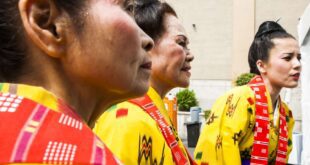The Whitewashing of Yoga: Exclusion and Commodification in America’s Wellness Culture
Wellness, a practice focused on holistic health, has grown popular in the Western sphere. From yoga and herbal medicine to crystals and the burning of sage, the industry has experienced exponential growth, ballooning to a global $4.4 trillion industry. The rise of wellness culture has helped raise mental health awareness. Yet, a troubling problem arises from the normalization of cultural practices into the American mainstream: the whitewashing and commodification of wellness and spirituality.
The Cultural Roots of Wellness
Wellness practices are usually rooted in Indigenous cultures and encompass traditions that have existed for centuries among South Asian and Native American backgrounds. But when introduced to the Western sphere, these communities are often ignored. The Western wellness industry has adopted practices from indigenous communities and turned them into commodified, luxury goods. As a result, wellness companies create exclusivity and marginalize the very communities these practices originated from.
The Danger of Aesthetic Gentrification in Yoga
Yoga, a popular and widely recognized discipline, is a prime example and serves as a general representation of how Western wellness culture is exclusive and commodified. Yoga is an ancient Indian practice deeply linked with spirituality. It originates from religions such as Hinduism, Buddhism and Jainism. The aim of yoga is to connect the mind, the body, and the spirit, and to advocate for mindfulness. But as the practice has gained popularity in the West, it has become diluted by aesthetic appeal and fitness.
One in 15 Americans practice yoga. Four-fifths of this group are white. The aesthetic gentrification of yoga further removes the practice from its cultural roots. It glamorizes the surface-level aspects and rejects the deeper philosophical inquiries that are intertwined with its origins. Unlike the gentrification of housing, aesthetic gentrification pertains to the appropriation and commercialization of certain parts of the practice without respecting and understanding the cultural significance and origins.
The Commercialization of Yoga
Lululemon, a company that profits from the whitewashed versions of yoga and meditation, exemplifies this commercialization by selling underwear with the slogan “namastay put,” making an insensitive pun out of the greeting “namaste.” Corporations capitalize from the popularity of wellness by creating these gimmicks without understanding the cultural roots. This reflects a broader problem in Western culture of selectively appropriating aspects of marginalized cultures and reducing Indigenous cultures to an aesthetic that can be sold to an exclusive elite.
The commodification of yoga has turned it into a luxury good, with a single yoga class costing upwards of $38. Yoga has become a privilege of the upper class. By reconstructing the practice to be a costly and exclusive pursuit, it excludes people from lower socio-economic backgrounds. This perpetuates the idea that wellness is only meant for those who can afford it and creates a financial barrier that restricts access to self-care.
The Broader Issue of Cultural Appropriation in Wellness
The issue of commercialization and exclusion does not just affect yoga but permeates into the broader wellness culture. Meditation and crystal healing are two more examples of how cultural traditions become transformed into luxury goods meant to primarily serve affluent individuals. Western wellness culture removes the original purpose of these practices requiring dedication and sells it as a shortcut to an idealized life.
Yoga instructors chant Sanskrit mantras as a mere prop to add “mysticality” to their practice and decorate studios with sacred symbols without understanding the meaning behind them. This spread of ignorance creates scrutiny over these alternative practices, as they are reduced to superficial trends. The credibility of cultural practices is undermined when Western culture leverages them as exploitative practices for profit.
The Need for Education and Awareness
Education and awareness are integral in fixing the commodification and exclusivity of yoga and wellness overall. Wellness is not something that should only be easily accessible to the privileged. It is essential to recognize that yoga is a sacred practice rooted in ancient cultures, not a trendy physical exercise that is a lifestyle accessory. Yoga instructors and studios have a responsibility to educate themselves on its history and provide proper context in their classes.
By emphasizing the roots of this ancient practice, Western culture can move away from exclusion and allow yoga to reclaim its origins of enabling holistic well-being for all. To make yoga and other wellness practices accessible for marginalized communities, the establishment of mindful community-based classes and partnerships can ensure that everyone, regardless of socioeconomic background, can partake in wellness culture.
 Mind Uncharted Explore. Discover. Learn.
Mind Uncharted Explore. Discover. Learn.


